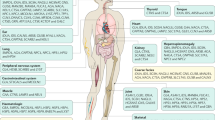Abstract
The primary biochemical consequence of a defect in a gene encoding a functional component of the lysosomal system is disruption of the catabolism or processing of macromolecules in the lumen of the lysosome. Transport of the resulting digestion products through the lysosomal membrane may also be affected. This leads to the accumulation of specific metabolites within the lysosomes of affected cells. The nature of these storage products depends upon the functional protein affected and the cell type. The accumulation of storage products is progressive and leads to hypertrophy of the lysosomal system, the hallmark of lysosomal storage diseases (LSDs).Subsequent cell necrosis or, possibly, exocytosis results in the appearance in body fluids of the storage products and components of the lysosomes at much higher concentrations than seen in normal unaffected individuals. Measurement of these increased levels of metabolites and proteins provides disease-specific and generic biochemical markers for LSDs. Secondary changes in metabolism and cellular function may also produce characteristic changes in the levels of metabolites or proteins, which can also be used as markers of the disease process. Although the rate of appearance of these biochemical markers in an individual will depend upon the underlying mutation in the gene and on other genetic and environmental factors, it provides a good indicator of the progression of the disease. As the novel forms of treatment being developed may reverse the hypertrophy of the lysosomal system, biochemical markers could also be used to monitor the reversal of pathology and the efficacy of treatment.
Similar content being viewed by others
REFERENCES
An Y, Young SP, Hillman SL, Van Hove JLK, Chen Y-T, Millington DS (2000) Liquid chromatographic assay for a glucose tetrasaccharide, a putative biomarker for the diagnosis of Pompe disease. Anal Biochem 287: 136–143.
Banerjee A, Burg J, Conzelmann E, Carroll M, Sandhoff K (1984) Enzyme-linked immunosorbent assay for the ganglioside GM2-activator protein. Screening of normal human tissues and body fluids, of tissues of GM2 gangliosidosis and for its subcellular localization. Hoppe-Seylers Z Physiol Chem 365: 347–356.
Boot RG, Renkema H, Verhoek M, et al (1998) The human chitotriosidase gene. J Biol Chem 273: 25680–25685.
Burditt AL, Chotai K, Hirani S, Nugent PG, Winchester BG, Blakemore WF (1980) Biochemical studies on a case of feline mannosidosis. Biochem J 189: 467–473.
Chang MHY, Bindloss CA, Grabowski GA, et al (2000) Saposin A, B, C, and D in plasma of patients with lysosomal storage disorders. Clin Chem 46: 167–174.
Chen C-S, Paterson MC, Wheatley CL, O'Brien JF, Pagano RE (1999) Broad screening test for sphingolipid-storage diseases. Lancet 354: 901–905.
Chitayat D, Nakagawa S, Marion RW, et al (1987) Elevation of serum ®-hexosaminidase and α-D-mannosidase in type 2 Gaucher disease: a clinical and biochemical study. J Inher Metab Dis 10: 111–114.
Hallgren P, Hansson G, Henriksson KG, Hager A, Lundblad A, Svensson S (1974) Increased excretion of a glucose-containing tetrasaccharide in the urine of a patient with glycogen storage disease type II (Pompe's disease). Eur J Clin Invest 4: 429–433.
Hollak CEM, van Weely S, van Oers CMJ, Aerts JMFG (1994) Marked elevation of plasma chitotriosidase activity. A novel hallmark of Gaucher disease. J Clin Invest 93: 1474–1478.
Hua CT, Hopwood JJ, Carlsson SR, Harris RJ, Meikle PJ (1998) Evaluation of the lysosomeassociated membrane protein LAMP-2 as a marker for lysosomal storage disorders. Clin Chem 44: 2094–2102.
Hultberg H, Isakson A, Sjoblad S, Ockerman PA (1980) Acid hydrolases in serum from patients with lysosomal disorders. Clin Chim Acta 100: 33–38.
Inui K, Wenger DA (1983) Concentrations of an activator protein for sphingolipid hydrolysis in liver and brain samples from patients with lysosomal storage diseases. J Clin Invest 72: 1622–1628.
Meikle PJ, Brooks DA, Ravenscroft EM, et al (1997) Diagnosis of lysosomal storage disorders: evaluation of lysosome-associated membrane protein LAMP-1 as a diagnostic marker. Clin Chem 43: 1325–1335.
Moffit KD, Chambers JP, Diven WK, et al (1978) Characterization of lysosomal hydrolases that are elevated in Gaucher's disease. Arch Biochem Biophys 190: 247–260.
Moran TM, Schofield JP, Hayman AR, Shi G-P, Young E, Cox TM (2000) Pathologic gene expression in Gaucher disease: up-regulation of cysteine proteinases including osteoclastic cathepsin K. Blood 96: 1969–1978.
Morimoto S, Yamamoto Y, O'Brien JS, Kishimoto Y (1990) Distribution of saposin proteins (sphingolipid activator proteins) in lysosomal storage and other diseases. Proc Natl Acad Sci USA 87: 3493–3497.
Nilsson O, Svennerholm L (1982) Accumulation of glucosylceramide and glucosylsphingosine (psychosine) in cerebrum and cerebellum in infantile and juvenile Gaucher disease. J Neurochem 39: 708–718.
Orvisky E, Sidransky E, McKinney CE, et al (2000) Glucosylsphingosine accumulation in mice and patients with type 2 Gaucher disease begins early in gestation. Ped Res 48: 233–237.
Potratz A, Huttler S, Bierfreund U, Proia RL, Suzuki K, Sandhoff K (2000) Quantification of mRNAs encoding proteins of the glycosphingolipid catabolism in mouse models of GM2 gangliosidoses and sphingolipid activator protein precursor (prosaposin) deficiency. Biochim Biophys Acta 1502: 391–397.
Salaspuro M, Salmela K, Humloja K, Arvio S, Palo J (1990) Elevated levels of serum dolichol in aspartylglucosaminuria. Life Sci 47: 627–632.
Sandhoff K, Harzer K, Wassle H, Jaztkewitz H (1971) Enzyme alterations and lipid storage in three variants of Tay-Sachs disease. J Neurochem 18: 2469–2489.
Simons K, Gruenberg J (2000) Jamming the endosomal system: lipid rafts and lysosomal storage diseases. Cell Biol 10: 459–462.
Svennerholm L, Vanier M-T, Mansson J-E (1980) Krabbe disease: a galactosylsphingosine (psychosine) lipidosis. J Lipid Res 21: 53–64.
Young E, Chatterton C, Vellodi A, Winchester B (1997) Plasma chitotriosidase activity in Gaucher disease patients who have been treated either by bone marrow transplantation or by enzyme replacement therapy with alglucerase. J Inherit Metab Dis 20: 595–602.
Author information
Authors and Affiliations
Rights and permissions
About this article
Cite this article
Winchester, B. Are there useful biochemical markers of disease activity in lysosomal storage diseases?. J Inherit Metab Dis 24 (Suppl 2), 52–56 (2001). https://doi.org/10.1023/A:1012415706901
Issue Date:
DOI: https://doi.org/10.1023/A:1012415706901




